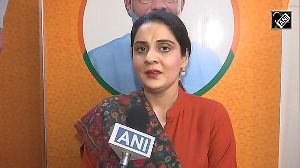The next time you are in Goa, watch closely. Holidaying there, sipping beer at the next table on the beach could be Pavan Nigam, the stocky 44-year old serial entrepreneur from the US.
He is currently the chairman, CEO and founder of Cendura Corporation, the Mountain View (California) start-up he created in 2001. Cendura helps companies monitor and manage the multiple applications running on their network.
Nigam, one of the Indians flourishing in Silicon Valley -- is also known for his association with the legendary Netscape founder Jim Clarke at Silicon Graphics, the cutting-edge tech firm, and with WebMD, the well-known online healthcare portal -- was in India recently to check on his development centre, set up in Hyderabad a year ago. According to him, being an entrepreneur is either a frustrating or satisfying experience.
"When you start a company, things are totally unknown; it is like a game of chess. Things are changing around you and one reacts and tries to control things, which are beyond your control. Overall, it is a challenging task," he says.
Things were no different at Cendura. His first 10 employees stood by him. They were paid no salaries for an entire year and got only sweat equity. "You need to believe in what you are doing and these guys believed in what Cendura was building," says Nigam.
In fact, believing in what he's doing is exactly what Nigam has been doing for most of his professional life. An electrical engineer from the Indian Institute of Technology, Kanpur, in 1980, he landed a job in the consumer electronics company Philips.
The fact that his Kanpur-based family ran a Philips dealership came in handy. He gave the Indian Administrative Service and the Indian Institute of Management Ahmedabad, where he had qualified, the go by, to do a masters in computer science at the University of Wisconsin at Madison (he completed this in 1982).
But Nigam's real tryst with the US began with big companies. He had a brief stint at Intel, before joining Jim Clarke at Silicon Graphics.
It helped that Clarke had a soft spot for Indians as he felt "they had the best software brains going." Clarke's big project then was interactive television. That never took off.
In 1994, when Clarke was edged out of SGI, Nigam and his team were left holding the baby. Costing $200 million to build, and with 200 people on the payrolls, it was a financial disaster. The cost of the interactive TVs that were to adorn American homes hit the roof, and not one was shipped out.
So he chucked it up, took a year off and "hung around for a while". That's when he was convinced that the Internet was the real big thing.
By then, Clarke had identified his own big thing -- Healtheon, an online healthcare company, and he invited Nigam to head the technical team.
"Once we knew that Internet technology was here to stay we discussed a lot on what would be the best possible and the most viable business to do. Finally after a lot of discussions we zeroed in on healthcare services as it was in a mess in the US," says Nigam.
In 1999, Healtheon went public. But merchant bankers wanted to call off the public issue when venture capitalists refrained from putting in more money. Clarke then pumped in $200 million.
In 2000, Healtheon merged with WebMD, MedE America and Medcast, which is a leader in providing services that help physicians, consumers, providers and health plans navigate the complexity of the US healthcare system.
"Healtheon was dedicated to help maintain information technology systems at their optimum capability while both increasing the quality of healthcare and minimising operational costs. But maintaining this company was not an easy task," recalls Nigam. In 2000, he finally left yet another company he co-founded, making a neat pile in the process.
He then made a beeline for -- where else? -- Goa. "While on holiday I was restless, not knowing what to do. And after considering several start-ups, I zeroed in on Web applications," he says.
That was the beginning of Cendura, which Nigam started largely with his own money in 2001. Since then, he has raised $15.5 million, with $8 million recently raised by NeoCarta Ventures, the venture capital firm.
"My first six employees worked for equity, not cash. They built two pilot products before taking in their first $7.5 million round of venture backing. The company has managed to utilise only $4 million of that," he says.
Actually, the second round of funding came as a surprise to Nigam, as he was not seeking any investment. "Now that this money has come in, we are looking at having offices across the US," he says.
Nigam claims that every entrepreneur has his own style and there is no fixed formula for entrepreneurship.
"I was very lucky right from my early days as I was involved in creating and heading teams at Intel and Silicon Graphics. So this was good training," he says.
No wonder, then, that he is a much sought after mentor who helps friends with their start-ups. "I have made a lot of investments in venture capital funds and those companies are doing well. I have invested directly in 12 companies and a lot of them have not done very well," he says. Now, isn't that what entrepreneurship is all about?





 © 2025
© 2025